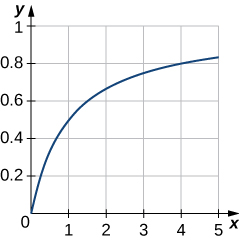7.4E: Exercises for Integration by Partial Fractions
- Last updated
- Jun 23, 2021
- Save as PDF
- Page ID
- 18290
( \newcommand{\kernel}{\mathrm{null}\,}\)
Use partial fraction decomposition (or a simpler technique) to express the rational function as a sum or difference of two or more simpler rational expressions.
1) 1(x−3)(x−2)
2) x2+1x(x+1)(x+2)
- Answer
- x2+1x(x+1)(x+2)=−2x+1+52(x+2)+12x
3) 1x3−x
4) 3x+1x2
- Answer
- 3x+1x2=1x2+3x
5) 3x2x2+1 (Hint: Use long division first.)
6) 2x4x2−2x
- Answer
- 2x4x2−2x=2x2+4x+8+16x−2
7) 1(x−1)(x2+1)
8) 1x2(x−1)
- Answer
- 1x2(x−1)=−1x2−1x+1x−1
9) xx2−4
10) 1x(x−1)(x−2)(x−3)
- Answer
- 1x(x−1)(x−2)(x−3)=−12(x−2)+12(x−1)−16x+16(x−3)
11) 1x4−1=1(x+1)(x−1)(x2+1)
12) 3x2x3−1=3x2(x−1)(x2+x+1)
- Answer
- 3x2x3−1=1x−1+2x+1x2+x+1
13) 2x(x+2)2
14) 3x4+x3+20x2+3x+31(x+1)(x2+4)2
- Answer
- 3x4+x3+20x2+3x+31(x+1)(x2+4)2=2x+1+xx2+4−1(x2+4)2
In exercises 15 - 25, use the method of partial fractions to evaluate each of the following integrals.
15) ∫dx(x−3)(x−2)
16) ∫3xx2+2x−8dx
- Answer
- ∫3xx2+2x−8dx=2ln|x+4|+ln|x−2|+C=ln|(x+4)2(x−2)|+C
17) ∫dxx3−x
18) ∫xx2−4dx
- Answer
- Note that you don't need Partial Fractions here. We use a simple u-substitution.
∫xx2−4dx=12ln|4−x2|+C
19) ∫dxx(x−1)(x−2)(x−3)
20) ∫2x2+4x+22x2+2x+10dx
- Answer
- Note that since the degree of the numerator is equal to the degree of the denominator, we need to start with long division.
Then note that we will need to use completing the square to continue since we cannot factor the trinomial in the denominator.
∫2x2+4x+22x2+2x+10dx=2(x+13arctan(1+x3))+C
21) ∫dxx2−5x+6
22) ∫2−xx2+xdx
- Answer
- ∫2−xx2+xdx=2ln|x|−3ln|1+x|+C=ln|x2(1+x)3|+C
23) ∫2x2−x−6dx
24) ∫dxx3−2x2−4x+8
- Answer
- ∫dxx3−2x2−4x+8=116(−4−2+x−ln|−2+x|+ln|2+x|)+C=116(−4−2+x+ln|x+2x−2|)+C
25) ∫dxx4−10x2+9
In exercises 26 - 29, evaluate the integrals with irreducible quadratic factors in the denominators.
26) ∫2(x−4)(x2+2x+6)dx
- Answer
- ∫2(x−4)(x2+2x+6)dx=130(−2√5arctan[1+x√5]+2ln|−4+x|−ln|6+2x+x2|)+C
27) ∫x2x3−x2+4x−4dx
28) ∫x3+6x2+3x+6x3+2x2dx
- Answer
- Note that we need to use long division first, since the degree of the numerator is greater than the degree of the denominator.
∫x3+6x2+3x+6x3+2x2dx=−3x+4ln|x+2|+x+C
29) ∫x(x−1)(x2+2x+2)2dx
In exercises 30 - 32, use the method of partial fractions to evaluate the integrals.
30) ∫3x+4(x2+4)(3−x)dx
- Answer
- ∫3x+4(x2+4)(3−x)dx=−ln|3−x|+12ln|x2+4|+C
31) ∫2(x+2)2(2−x)dx
32) ∫3x+4x3−2x−4dx (Hint: Use the rational root theorem.)
- Answer
- ∫3x+4x3−2x−4dx=ln|x−2|−12ln|x2+2x+2|+C
In exercises 33 - 46, use substitution to convert the integrals to integrals of rational functions. Then use partial fractions to evaluate the integrals.
33) ∫10ex36−e2xdx (Give the exact answer and the decimal equivalent. Round to five decimal places.)
34) ∫exe2x−exdx
- Answer
- ∫exe2x−exdx=−x+ln|1−ex|+C
35) ∫sinxdx1−cos2x
36) ∫sinxcos2x+cosx−6dx
- Answer
- ∫sinxcos2x+cosx−6dx=15ln|cosx+3cosx−2|+C
37) ∫1−√x1+√xdx
38) ∫dt(et−e−t)2
- Answer
- ∫dt(et−e−t)2=12−2e2t+C
39) ∫1+ex1−exdx
40) ∫dx1+√x+1
- Answer
- ∫dx1+√x+1=2√1+x−2ln|1+√1+x|+C
41) ∫dx√x+4√x
42) ∫cosxsinx(1−sinx)dx
- Answer
- ∫cosxsinx(1−sinx)dx=ln|sinx1−sinx|+C
43) ∫ex(e2x−4)2dx
44) ∫211x2√4−x2dx
- Answer
- ∫211x2√4−x2dx=√34
45) ∫12+e−xdx
46) ∫11+exdx
- Answer
- ∫11+exdx=x−ln(1+ex)+C
In exercises 47 - 48, use the given substitution to convert the integral to an integral of a rational function, then evaluate.
47) ∫1t−3√tdt;t=x3
48) ∫1√x+3√xdx;x=u6
- Answer
- ∫1√x+3√xdx=6x1/6−3x1/3+2√x−6ln(1+x1/6)+C
49) Graph the curve y=x1+x over the interval [0,5]. Then, find the area of the region bounded by the curve, the x-axis, and the line x=4.

50) Find the volume of the solid generated when the region bounded by y=1√x(3−x),y=0,x=1, and x=2 is revolved about the x-axis.
- Answer
- V=43πarctanh[13]=13πln4units3
51) The velocity of a particle moving along a line is a function of time given by v(t)=88t2t2+1. Find the distance that the particle has traveled after t=5 sec.
In exercises 52 - 54, solve the initial-value problem for x as a function of t.
52) (t2−7t+12)dxdt=1,t>4,x(5)=0
- Answer
- x=−ln|t−3|+ln|t−4|+ln2=ln|2(t−4)t−3|
53) (t+5)dxdt=x2+1,t>−5,x(1)=tan1
54) (2t3−2t2+t−1)dxdt=3,x(2)=0
- Answer
- x=ln|t−1|−√2arctan(√2t)−12ln(t2+12)+√2arctan(2√2)+12ln4.5
55) Find the x-coordinate of the centroid of the area bounded by y(x2−9)=1,y=0,x=4, and x=5. (Round the answer to two decimal places.)
56) Find the volume generated by revolving the area bounded by y=1x3+7x2+6x,x=1,x=7, and y=0 about the y-axis.
- Answer
- V=25πln2813units3
57) Find the area bounded by y=x−12x2−8x−20,y=0,x=2, and x=4. (Round the answer to the nearest hundredth.)
58) Evaluate the integral ∫dxx3+1.
- Answer
- ∫dxx3+1=arctan[−1+2x√3]√3+13ln|1+x|−16ln∣1−x+x2∣+C
For problems 59 - 62, use the substitutions tan(x2)=t, dx=21+t2dt, sinx=2t1+t2, and cosx=1−t21+t2.
59) ∫dx3−5sinx
60) Find the area under the curve y=11+sinx between x=0 and x=π. (Assume the dimensions are in inches.)
- Answer
- 2.0 in.2
61) Given tan(x2)=t, derive the formulas dx=21+t2dt,sinx=2t1+t2, and cosx=1−t21+t2.
62) Evaluate ∫3√x−8xdx.
- Answer
- ∫3√x−8xdx=3(−8+x)1/3−2√3arctan[−1+(−8+x)1/3√3]−2ln[2+(−8+x)1/3]+ln[4−2(−8+x)1/3+(−8+x)2/3]+C


